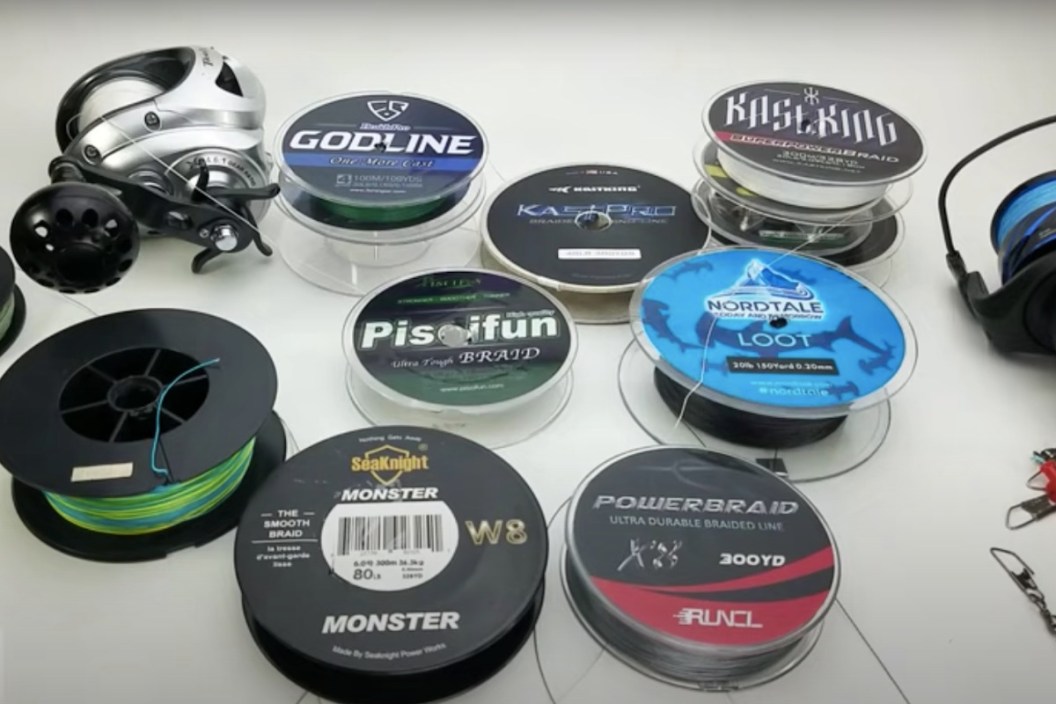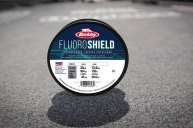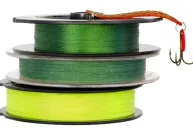Once we first heard about braided fishing line and what it could do, we were hooked.
For the uninitiated, braided fishing line is made from manmade materials such as Dacron, Spectra, and Micro-Dyneema. These lines are meant to be the last line of defense against break-offs due to lack of a good drag when fighting larger fish and are deemed to be unbreakable.
That may all sound well and good, but braided line can be cut and broken like any other line types like monofilament and fluorocarbon.
On the upside, braid has tremendous sensitivity and feel for the fisherman. This allows it to be used in the heaviest of cover. Pro bass fishing anglers everywhere began to prove this fact in tournaments across the nation as fans watched them pull bass after bass out of the heaviest slop and weed mats.
It's said that braid can be slippery and that you have to tie it correctly or it will come undone. In my experience that is all in the hands of the participating angler. Braid ties up tight and lasts quite well on a lure, hook, or a ball bearing snap swivel. What matters most is making sure the knot is tied correctly.
Sure, knot choice is key here too. We believe the Palomar knot is probably the best of these. However, not paying attention to detail while tying can cause a catastrophic failure at the moment of truth.
Braided Fishing Line Facts
It's easy to see why many advanced brands like Berkley Fireline, Daiwa J-Braid, Power Pro Maxcuatro, Spiderwire Stealth Braid, and Sufix Advanced Superline have become best sellers in the fishing industry. These lines work extrmely well in both freshwater and salt, and they offer many great benefits over more traditional monofilament lines.
Spectra and Dyneema are basically the same thing, with one name being used in the U.S. and the other around Europe. As you can see in the video, just the process of making braid is a long and expensive one. If you've ever priced it in the stores, you've likely done a double-take at the price tag. The complicated manufacturing process is why braided line is so much more money than mono or fluorocarbon.
Some braided lines are made more for a basic purpose. They're not flashy, but have the strength and efficiency to keep your offering in the target zone and pulling fish out without much difficulty.
Other braids are made for more specific purposes such as PowerPro's Slick 8 or Cabela's RipCord Si which are great for casting distance and quiet performance. These aren't quite as specialized for plowing through the cover such as other braids are, but more for finesse fishing and even better in clearer water.
Other specialized braids of today have even more power, abrasion resistance, and are thin as ever in their ability to hide from fish. These bode quite well for the saltwater fishing crowd and the bigger reels needed to target ocean dwelling species.
This also means that they have all the same refinements of the others, all packed into one spool. The only issue with these: they are the most expensive of all the braided lines.
Using Braided Line
Braided lines, depending on the brand, can come in everything from white, blue, or green to some crazy multi-colored versions that work just fine. It is said that to use it in clear water can be a problem since it shows up in the water column too much, spooking the fish. The brand used in the above video that I took back in 2018 was PowerPro braid, 20-pound test, 6-pound diameter line on an ultra-lite spincast setup.
Personally, I use braid in some very clear water fishing situations, and if you take the time to deal with the issue, it won't create any trouble for you. Not only that, but it can be purchased in some incredibly small diameters that cast extremely well, and disappear, even in clear water.
Braid is quite well suited in situations like the heavy vegetation of lily pads and hydrilla. It's great for deep water presentations like drop shotting, and as a trolling line. Casting with braid can be a breeze thanks to the low diameter and sometimes silky-smooth materials. This can make it a great choice for a beginner fisherman.
This stuff is built to last, and is the strongest line type pound for pound out there. It has no memory to speak of, and it flows off of every reel like a dream. This stuff is great for deeper water fishing since strikes can still be detected easily, and solid hook sets can be made.
Sure, there are many line types out there made for specific fishing situations, (which all should be taken under consideration) but the bottom line is that braid can be used under almost any circumstances.
The Downside of Braid
As said, braid shows up loudly under some clear water circumstances making it less than ideal for some anglers and fishing situations. Braided fishing line is said to have a lower abrasion resistance than the others, but I don't always see that issue.
When used on a baitcasting reel and a backlash occurs, you can almost always kiss it goodbye since getting it out usually takes a knife or a pair of braid blades. In the beginning days of braided line use, it was said to have cut into the rod guides and the bail on a spinning reel. However, I have been using braid virtually since these first superlines have come out, and I've never seen any of that happen to any of my gear.
Honestly, I've been dumb enough to try breaking it off in my hands. I don't recommend it because it cut into my fingers. I almost always have to put backing on my spinning reel and sometimes on my baitcasting reel to keep it from spinning around on the spool by itself. I always take the time to wind it on, and then go outside somewhere with a lot of room. Then I hook a lure to a fence post, and walk away as far as I can.
The point is to then reel it back onto my fishing reel as tightly as possible to keep it from looping later.
The Bottom Line
As said, the immediate advantages of braid are its incredible strength, (even in smaller diameters) it has no stretch, and it casts extremely well. For fishing in heavy cover, nothing gives an angler more peace of mind than knowing that his bait is tied to some of today's seemingly indestructible braided superline.
Braided fishing line has been around for a long time, but the most recent and strongest versions of these lines have broken on the scene in just the last couple of decades. If you're like me, you remember that old ad that said using it was like "hitting a brick with a lawnmower." Make no mistake, the low stretch, high strength lines that are braided have some big upsides, but a few downsides as well.
Products featured on Wide Open Spaces are independently selected by our editors. However, when you buy something through our links, we may earn a commission.
Looking for a little more or even hot lunch for your hunting blind? Follow my webpage, or on Facebook and YouTube.
NEXT: 5 ETHICAL FISHING QUANDARIES
WATCH





